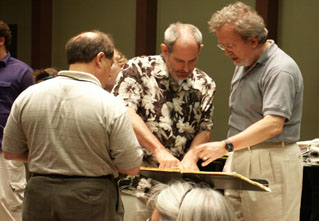Last week, in my Monday Morning Email newsletter, I posed the following questions:
I’ve been thinking about our societal emphasis upon size, and the corollary that bigger is better. I know from experience that it can be an awkward, difficult, and/or frustrating thing to serve in a small or mid-sized church near a mega church. I’ve seen how being in that situation can lead to fits of envy and jealousy. Yet many small churches, like the one I now serve, thrive and flourish. How does that happen? Do you serve in a situation where there is a mega church nearby? How do you deal with that? How does your church and/or your ministry differentiate yourself from the big church? And how is that working? What have you learned from being in that situation?
I’m not sure why, but I had many fewer replies than has been typical, but they provided good insight nonetheless.
Rusty Rabon checked in with this:
I was having coffee with a friend of mine last week, and we were talking about the differences between large and small churches. Now, my friend is no traditionalist – he really breaks the mold in a lot of ways – but he said that he much preferred smaller fellowships than the larger ones that use all of the latest “gadgets and gimmicks” because in smaller ones you tend to find people who are real and worship that is genuine.
Then he reminded me of a song from the early days of contemporary Christian music by a man named Chuck Girard titled “Little Country Church.” In the song, people went there because they found bread and people genuinely “praised the Lord.”
There’s nothing evil about “big” nor holy about “small.” I prefer to ask whether we are being all that the Lord would have us be, and are we being faithful to do the things Scripture says we should be doing – “ascribing to the Lord the glory due to his name,” making disciples, and caring for those in need.
Barbara Arnold sent me her impressions of a particular church in Southern California:
I am now retired from Music Ministry, but I sub for colleagues who need a vacation or just a “Break”. I am impressed with the First United Methodist Church of Seal Beach, California. The small church seats about 90 people. It is 2 blocks from a large church which has 3 services, lots of up to date electronics, screens, music, etc.
First church has a little sound system with 3 microphones. The music is all live and not electronically enhanced. The people who come to worship here tell me they love to be away from all the loud electronic sounds, and that they enjoy reading music from a book! How long has it been since we’ve heard that!
Both churches have ministers who are great leaders, and stick to the Bible in their sermons. Both churches have very similar content in their services. However, I learned that there are some 30 to 40 year olds with young families who are becoming hungry for the close feeling they have in a small church. They enjoy choir music and singing from a Hymnal. It was refreshing.
Finally, Chip Stam of Southern Baptist Theological Seminary in Louisville, gave a lot of detail about the church in which he serves:
I serve a church that is about 300 in membership. (100 children under the age of two–so many of our members are young couples at Boyce College or The Southern Baptist Theological Seminary.) There are some mega churches here in Louisville, but they are really not a discouragement to those of us who are ministering in smaller Reformed-minded Southern Baptist Churches. Once there is a critical mass of folks, the emphasis is on faithful, biblically rich, Christ-centered, Spirit-led ministry, rather than on size.
Our church has planted two sister churches in the last four years. We have decided to go this direction rather than have multiple services or expand or move. We also have a large instance of what we call “gathering and scattering.” Many students are with us for about four years, longer if they are moving to a Ph.D. Then they go to a ministry position in a church or with a mission board overseas.There are nine elders/pastors. Three of the elder/pastors are part-time paid staff, one is full-time. I am part-time with the church (music and worship) and full-time with the seminary. As in most Reformed-minded Southern Baptist Churches, the membership process is rather demanding, and the Covenant of Fellowship requires quite a bit (compared to churches where a person can join on the morning he or she visits for he first time).To join:1. Attend the the “Membership Matters” morning seminary offered about four times a year. (four hours on a Saturday)2. Interview with two of the elders3. The candidates for membership answer some questions in the church newsletter so that the membership can read about how they came to faith in Christ and what they understand the gospel to be, and can get to know them and learn about the evidence of grace in their lives.4. The candidates must have been baptized by immersion after conversion and must affirm that they are trusting in Christ alone for forgiveness of sin and hope of eternal life5. Finally, they are voted on individually by the congregation at a Sunday evening service.We have a 1940ish, four-story building with an auditorium that seats about 350-400. It is paid for completely. Our budget for 2010 is about $350,000.
In the church at which I serve, First Presbyterian in Templeton, California, I’ve noticed that it is not about size at all, even though there is a mini mega church in our same denomination, in the next town, within about 10 miles of us. The only people who talk about size are the staff, and then not very often. What we do talk about…a lot…both congregation and staff, is the spirit of the church, and the people. I have, quite simply, never served in a place that is more welcoming, more genuine, and more caring across the board. That is not to say that I’ve never served with welcoming, genuine or caring people, it is just that this church does it effortlessly, and with a wonderful spirit.
We’ve gotten a few refugees from the mega church, but more importantly, it is clear that our shared mission is to serve our own community, both the town around us, and those that worship with us. To be honest, what they are doing at the mega church has never been a topic of conversation, which I think is a good thing. We are who we are, and we serve together for the benefit of the Kingdom. I think that Rusty, Barbara, and Chip’s examples share the same characteristics, so there must be something to it. It certainly works for us.
How does your church look at size? I’d love to hear what you think? Please leave a comment below.
…
You can follow me on twitter here
Get my EBook The Choir in Modern Worship here
Join me on facebook here












{ 2 trackbacks }
{ 2 comments… read them below or add one }
Here at Irvine Presbyterian Church in southern California, we serve in the shadow (or is it the light?) of two major mega-churches (Saddleback and Mariners) and a variety of other very large churches. By comparison, our average adult worship attendance last year was 507. Yes, I know, by most standards we are a large church, too.
When we are at our best, we don’t consider ourselves in competition with anyone. Our desire is that people come to know and follow Jesus as Lord. For a particular individual or family, whether that is best accomplished here at IPC, or at Saddleback or in a smaller congregation down the street is inconsequential. We find that, for some people, it is a matter of life-stage. There is a time when the mega-church offers something that best helps them on their discipleship journey OR their particular gifts can best be used for God’s glory in that context. Then, there are times when a more intimate setting or different forms of worship bring folks in the other direction. Of course, we don’t encourage changing churches like changing socks! We hope people will prayerfully and intentionally make these decisions, and do so with the long haul in mind, not just whatever tickles their fancy at the moment.
Now, I said at our BEST we don’t consider ourselves in competition. It will come as no surprise that we are not always at our best! Our dark side ranges from imitation to denigration. Imitation: “let’s try to do it the way the big boys do!”….which usually leads to futile and mediocre results. Denigration: “we would NEVER do it that way! They’re all show and no content” which simply must sadden our Lord, who prayed that we would be one as he and the Father are one.
In Reggie McNeal’s book, “Missional Renaissance: Changing the Scorecard for the Church,” the last of the three missional shifts he proposes is “from church-based to kingdom-based, in terms of leadership agenda.” As leaders in Christ’s church, we must train our thinking, speech and behavior toward his prayer that the Father’s “kingdom come” and his “will be done on earth as it is in heaven” rather than toward building our own little kingdoms in our individual congregations.
God help me to practice what I preach!
Thanks for the wonderful words, Dan. I agree…size, in many ways, is a function of attitude (sort of like age). To paraphrase the old saw: you are (only) as big as you think you are.
I must confess that I’ve served at several churches who almost seemed obsessed with what the “big church” was doing. I suppose that it is human nature to be competitive, but I think you outline a great approach by focusing upon the season of life for the church and its congregants.
You must log in to post a comment.